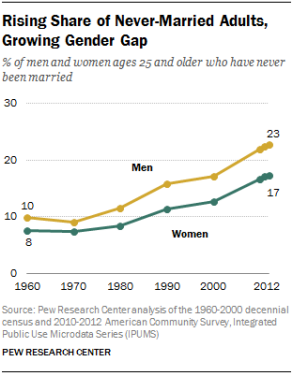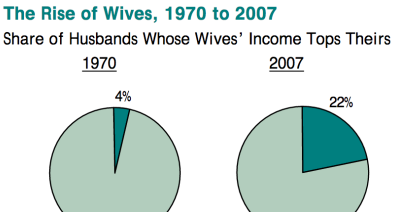It’s an exciting time for us in the United States! Why? Because we have hit an all-time high for adults who have never been married. One in five adults aged 25 and older have never been married. Men are more likely than women to have never been married (23% vs. 17% in 2012). “And this gender gap has widened since 1960, when 10% of men ages 25 and older and 8% of women of the same age had never married.”102

Figure \(6.7.1\) Rising Share of never-married adults, growing gender gap.
The median age at the time of the first marriage is now 27 for women and 29 for men. This is up from 20 for women and 23 for men in 1960, and about a quarter (24%) of never-married young adults ages 25 to 34 are living with a partner.103 This trend cuts across all major racial groups but has been more pronounced among African Americans, wherein African Americans went from 9% to 36% and Whites went from 8% to about 16%.
Married people (43% very happy) are a good bit happier than unmarrieds (24%). This trend has been consistent in research over several decades. In fact, marriage is one of the biggest indicators for self- satisfaction and happiness in adults’ lives. It holds up for men as well as for women, for homosexual and heterosexual, and for the old as well as the young. So, marriage is more than “just a piece of paper” and not all marriages are created (or interpreted) as equal. For example, if you were a visitor from another planet and attempted to explain marriage to beings where you were from originally by looking at popular culture, you’d probably have to conclude that marriage is almost exclusively sold, bought, and desired by women. What do I mean by that? Wedding magazines are aimed almost exclusively at brides, not grooms. Reality TV shows highlight Bridezillas, not Groomzillas and “Saying yes to the Dress” instead of the tuxedo. “If you like it, then you should have put a ring on it.”—Queen B. Meanwhile, men are often depicted as being commitment-phobic, uninterested (or uninvited) in planning a wedding, or as thought hey are making the “ultimate sacrifice” (their singlehood) for someone. Marriage is depicted as being natural for women, but stifling for men.
These images in popular culture are not completely fiction, as our interpretations of our ender roles are largely shaped by popular culture. For example, research shows women tend to find marriage more appealing than do men. Nearly two-thirds of married same-sex couples are lesbians, and only about a third are gay men.104 Women tend to be more marriage-focused, be they homosexual or heterosexual.
But while women tend to be more wedding-focused, what about some of those benefits of marriage mentioned earlier? Do women and men enjoy those equally? In fact, the answer is no. Research has shown the “marriage benefits”—the increases in health, wealth, and happiness—are disproportionately enjoyed by men. Married men are better off than single men in these categories. Married women, on the other hand, are not better off than unmarried women. In fact, in the one area where men were traditionally the beneficiaries in different-sex marriages (wealth) men are actually benefitting economically more from marriage today than are women. “In the past, relatively few wives worked, so marriage enhanced the economic status of women more than that of men. In recent decades, however, the economic gains associated with marriage have been greater for men than for women.”105 Since folks with higher incomes are more than those with lower incomes to marry instead of cohabit, and we tend to marry endogamously (so upper class people with upper class people) people higher up the class ladder tend to retain privileges or even increase them through marriage. Households where there are two high income earners are also more likely to be in the upper middle class, cementing further the class divide and the accompanying resources.

Figure \(6.7.2\) The Rise of Wives, 1970 to 2007
102 Pew Research Report. 2014. Record Share of Americans Have Never Married.
http://www.pewsocialtrends.org/2014/...-americans-hav e-never-married/
103 U.S. Census Bureau table MS-2. (http://www.census.gov/hhes/families/data/marital.ht ml).
104 Badgett, M.V., Herman, J. 2011. Patterns of Relationship Recognition by Same-Sex Couples in the United States. The
Williams Institute.
105 Richard Fry and D’Vera Cohn. 2010. “Women, Men and the New Economics of Marriage”. Pew Research Center.
http://www.pewsocialtrends.org/files...f-marriage.pdf




